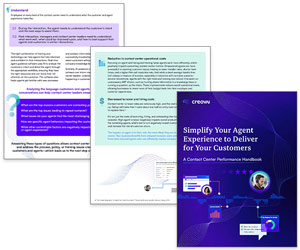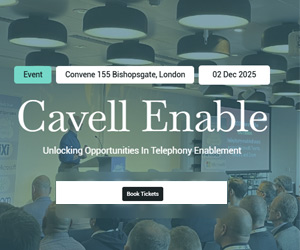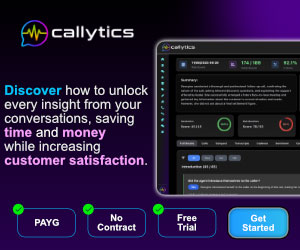Daniel Ord argues that if you can make better choices around the topics of quality and productivity, you’re on the way to improving performance.
The best definition of the contact centre agent job looks like this:
The job of a contact centre agent is to do the right things at the right time.
“Doing the right things…” translates readily to quality, while “at the right times…” translates readily to productivity.
Let’s look at some of the best choices you can make in these two areas, starting with quality.
“Doing the right things…” – Quality
Let’s look at some important choices you can make to help your agents improve their quality.
1. Develop a compelling service delivery vision
When you try to please everyone, you end up pleasing no one.
When you try to please everyone, you end up pleasing no one.
That’s a powerful statement and an important one when you’re looking to deliver industry-leading quality.
Every organisation has its own purpose, its own set of customers and its own ‘style’ and brand.
That means it should have its own kind of service too.
Service that everyone understands at a big-picture level – and that helps guide them in their customer interactions.
Don’t just tell your people to wear black socks, say the customer’s name three times and avoid overuse of the hold button.
Provide your agent with a solid understanding of ‘the kind of service we deliver around here’ via a meaningful service delivery vision.
Even better, include their voice in the dialogue and design of the service delivery vision.
Wouldn’t it be great if each agent could say –
“I know exactly what kind of service we deliver around here, how to explain it to others and how to bring it to life in my job role.”
2. Select the right performance standards – by channel – train them well and keep them up to date
Every channel – whether live chat, email or good old voice – has its own set of appropriate practices.
Blend those practices with your desired service delivery vision (or customer experience strategy if you prefer) and then methodically select and define performance standards that are truly relevant for the success of each channel you offer.
In my work with clients, I regularly meet centres who ask their agents to ‘practise’ on their customers. These include:
- Email agents who have never been formally trained in email writing practices – or have little guidance about what separates a weak email from a great email.
- Live chat agents who are told to start handling live chats without a background or understanding of what separates a weak chat from a great chat.
- Voice agents who may have received orientation training at the time of hire, but don’t receive any further or updated training to address evolving customer expectations, needs and wants.
Or even address the very human need to keep learning and growing.
It’s hard to be an agent who is tasked to practise on customers.
It can hit your self-esteem, your motivation and of course your individual quality score when someone in quality assurance decides to mark you down.
Quality assurance (QA) should be an enabler – not a barrier.
Wouldn’t it be great if each agent could say:
Quality Assurance (QA) should be an enabler – not a barrier.
“I know the ‘why’ behind the performance standards my organisation chose to measure quality, and I appreciate that there are mechanisms in place to continuously train and equip me to do well in quality – across every channel I handle.”
3. Implement proper transactional coaching practices
Talking to someone about a ‘bottom box’ satisfaction rating from a customer or conducting ‘Below Expectations’ coaching when someone fails one of their performance standards is not coaching.
You should call it what it really is. A ‘poor performance’ conversation.
In people management you learn that the goal of a poor performance conversation is to help the employee understand what was ‘poorly’ done, the potential consequences and – as needed – how to avoid the poor performance again.
But a poor performance conversation is not the same as a transaction coaching conversation.
It’s not enough to just help agents avoid ‘being bad’ – which some agents never are in any case.
True transaction coaching is developmental in nature. And it’s always about two sides – what went well and what can be improved.
Agents who only hear what they did wrong understandably disengage, dislike ‘coaching sessions’ and become mistake-avoiders instead of brand communicators.
Wouldn’t it be great if each agent could say –
“I receive regular and helpful feedback about my quality performance which helps me understand where I do well and where I can improve.”
4. Keep story-telling, rituals and appropriate rewards front and centre in your agent’s life
Telling your people that customers ‘matter’ or that your organisation is ‘truly’ customer-centric will only take you so far.
Make it real and build your customer-focused aspiration into the work lives of your contact centre agents.
Story-telling looks at what customers have to say – not what we have to say about them.
Providing access to customer verbatim from surveys, compliment and complaint letters, and to digital call files and transcripts that highlight the customer’s point of view, are all common examples of storytelling.
Conducting video interviews with customers on topics around their needs, wants and expectations for share with agents is another great example.
And increasingly, the roll-out of ‘Customer Days’, where agents have the opportunity to sit down and talk to customers about what matters most to them can be a real eye-opener as well.
Rituals are customer-oriented activities that you embed into the work lives of your agents to reinforce and demonstrate your commitment to customers.
They should be ‘regular’, which means that they happen on a regular, predictable basis or are triggered by regular events such as the presentation of the latest customer survey results.
Daily huddles to share customer handling ideas, regular celebrations around customer-oriented achievements and periodic time off the phone to come up with new ideas for enhancing the customer experience, are all examples of rituals.
There are so many fun and creative ways to build powerful rituals into your agent culture. Just ask your agents if you’re struggling for ideas.
There are so many fun and creative ways to build powerful rituals into your agent culture. Just ask your agents if you’re struggling for ideas.
And lastly, culture builders will tell you that informal and formal rewards – designed around quality – not just productivity – can be real motivators.
As Daniel Pink advises, watch out for too many if-then rewards (i.e. you do this and then you get that) and look out for ‘now-that’ rewards (now that you’ve improved so much in X you deserve this recognition).
Wouldn’t it be great if each agent could say –
“My organisation walks the talk on customer experience. Storytelling and rituals keep me in tune with what customers want, need and expect, and relevant rewards are fun and motivating.”
“At the right time…” – Productivity
Let’s look at some important choices you can make to help your agents improve their productivity.
1. Stop measuring the wrong things
More than anything else, the key to agent productivity is to understand what agent productivity is – and what it isn’t.
Let’s start with what it isn’t:
It isn’t Average Handling Time (AHT) – the significant drivers of AHT don’t lie in the control of agents – they lie in process, technology and complexity experienced by customers.
Leading centres measure individual AHT to identify outliers for root cause analysis – but they don’t consider AHT a viable productivity metric at the agent level. It’s better used for accurate forecasting and staff planning.
Leading centres measure individual AHT to identify outliers for root cause analysis – but they don’t consider AHT a viable productivity metric at the agent level.
For centres that still want some aspect of AHT in their agent performance scorecard, they simply assign it a low weighting in the overall ‘basket’ of productivity KPIs.
It isn’t Number of Calls Handled – the mathematic realities of service-level based contacts like calls and live chats mean that agents don’t control the number of interactions handled.
Only response-time contacts, such as correspondence and email, can have appropriate volume-based targets.
That’s because the mathematical realities of service level and response time-based contacts are different.
It isn’t Occupancy – Agents don’t control how ‘busy’ they are when they are signed in handling service-level-based contacts.
Management is the ultimate driver of Occupancy through key actions such as setting service level objectives, forecasting & staffing, and managing service level in real time.
In addition, mathematical realities such as the Pooling Principle only further highlight how wrong it is to target agents on their personal Occupancy rates. The Pooling Principle teaches that even at the same service-level achievement, occupancy rates fluctuate based on group size.
If you consider these three points further, you’ll see that each one – when targeted at the agent level – has a direct and largely negative impact on agent quality.
You can’t set KPIs in contention and expect to earn agent performance. There is no such thing as a ‘balance’ here.
Rather than earning performance, setting KPIs in contention will earn you agent confusion and a host of unwanted outcomes.
Selecting the right KPIs for the right job roles is a senior leadership responsibility. It’s super-important to get it right.
It’s not so great when your agent says –
“I work in a centre that asks me to achieve both productivity and quality but then sets KPIs that compete with each other. This situation not only puts me in a confusing position but makes it hard to meet my targets. So that in turn drives me make some uncomfortable shortcuts.”
2. Measure the right things
We turn back to our definition of the job of a contact centre agent:
The job of a contact centre agent is to do the right things at the right time.
At the right time is best expressed through the important KPI of Adherence to Schedule.
Simply put, when your agent adheres to the schedule they’re given – at an interval level – your centre service level improves and stabilises.
It makes intuitive sense.
When your agent adheres to the schedule they’re given – on an interval basis – your centre service level improves and stabilises.
When you’re short by even a small number of agents, your service level goes down and all sorts of important KPIs go awry.
When you’re overstaffed by any number of agents, your service level barely improves – meaning you’re wasting organisational resources.
Putting the right people in the right place at the right time is not just a mantra – but a way to manage your frontline resources efficiently.
The challenge – at times – can be to help agents understand why this is so important at an individual level.
Because it’s tempting – even natural – for an agent to think, “well, I’m only one of X many on the phones or live chats today, so it won’t make much of a difference if I’m a bit late or take a bit of a longer lunch.”
The Power of One teaches us that being under-capacity by even one agent can cause service level to fall precipitously.
The Law of Diminishing Returns teaches us that being over-capacity is a waste of resources because agents over and above what we need bring very little reduction in customer wait time.
At a management level, you need to ‘marry’ effective interval-based forecasting, staffing and scheduling with the appropriate Adherence to Schedule behaviour of individual agents.
You can’t wing this part – and you most certainly can’t run an effective centre without a strong workforce management function and expect agent performance to make up the shortfall.
If you are indeed trying to move agents here and there based on what’s happening in ‘real time’, you’re going to have a serious credibility issue with your agents as to how much mastery you have of the environment.
And that kind of chaotic environment doesn’t earn the performance of its contact centre agents.
Of course, much more can be (and has been) written on workforce management and practices that improve engagement – such as easy shift-swaps and flexible scheduling.
But for purposes of this article, I’ll stay focused on how important it is to understand what productivity is and measure it the right way.
Wouldn’t it be great for your agent to say –
“I work in a centre that has defined productivity very clearly for me – and explained the rationale behind it. I understand how my individual contribution has a big impact on our overall performance and why I need to be in the right place at the right time.”
Summing up Productivity and Quality (P & Q)
One of the powerful aspects of the Productivity (P) and Quality (Q) approach I’ve shared is that P & Q don’t contradict each other.
You can ask for both.
You can ask your contact centre agent to do the right things, at the right times, with clarity and purpose.
With that said, there’s one more dimension I’d like to look at before closing this article – and that’s the power of attitude.
Nobody has an attitude problem
It’s quite normal to hear a manager say, “I think my contact centre has an attitude problem.”
But is this a fair assessment?
I don’t think so.
There’s really no such thing as an ‘attitude problem’ because there are so many different attitudes at play in any job role.
In my former VP Operations days, if a manager came into my office and said they had an agent with an attitude problem, I’d ask them to tell me specifically which attitude was involved.
If they couldn’t, I’d recommend that they figure it out and then come back and see me.
Was I being overly harsh? I don’t think so.
Every job, from the top on down, requires a certain set of attitudes to succeed.
And it’s our job to know the attitude requirements for any job role we manage – in this case the contact centre agent.
Common attitudes I come across for contact centre agents include–
- Adaptability and flexibility
- Positive attitude
- Consistency
- Confidence
- Control
- Goal-orientation
- Teamwork
But I’d recommend going through the work of selecting and defining the attitudes that make the most sense for your centre.
What it helps to know about attitude(s)
Nobody is a superstar at every attitude.
Some attitudes were inculcated in us through how we were raised, some we learned from trusted teachers and mentors.
Others were learned from role models, siblings and friends we admire.
Attitudes evolve and develop over time – especially with the right guidance.

Daniel Ord
For me, I’ve found the following two thoughts about attitude to be helpful:
- An attitude is a settled way of thinking or feeling about something
- Attitudes are choices – people can choose and/or change their attitudes over time
When helping someone develop a specific attitude, our goal – our endgame – is that they end up making a conscious and personal choice to adopt the right attitude for their success.
In closing
When you’re able to earn the quality, productivity and attitudes from your contact centre agent, life is good.
Thanks to Daniel Ord, the Founder and Director of OmniTouch International
Find out how else you can improve contact centre performance, by reading our articles:
- How to Improve Agent Performance in the Call Centre – With a Checklist
- 12 Great Tips to Improve Call Centre Performance
- The Un-Contact Centre: 8 Guidelines to Improving Contact Centre Performance
Author: Daniel Ord
Reviewed by: Jonty Pearce
Published On: 30th May 2018 - Last modified: 18th Aug 2025
Read more about - Call Centre Management, Agent Performance, Daniel Ord, Editor's Picks, Management Strategies, Performance Management, Productivity, Quality










































